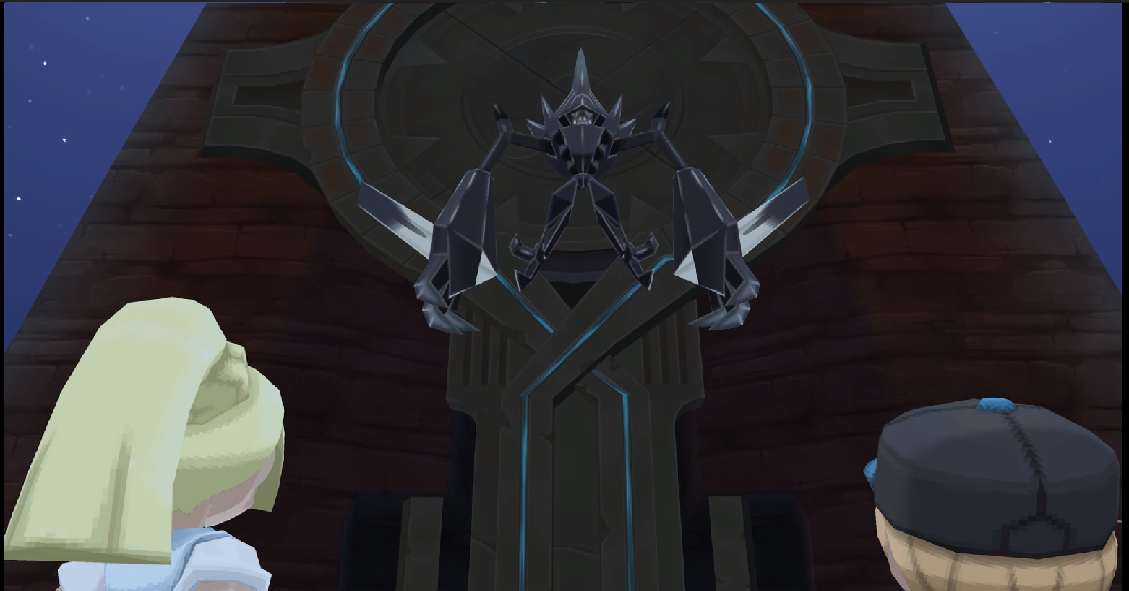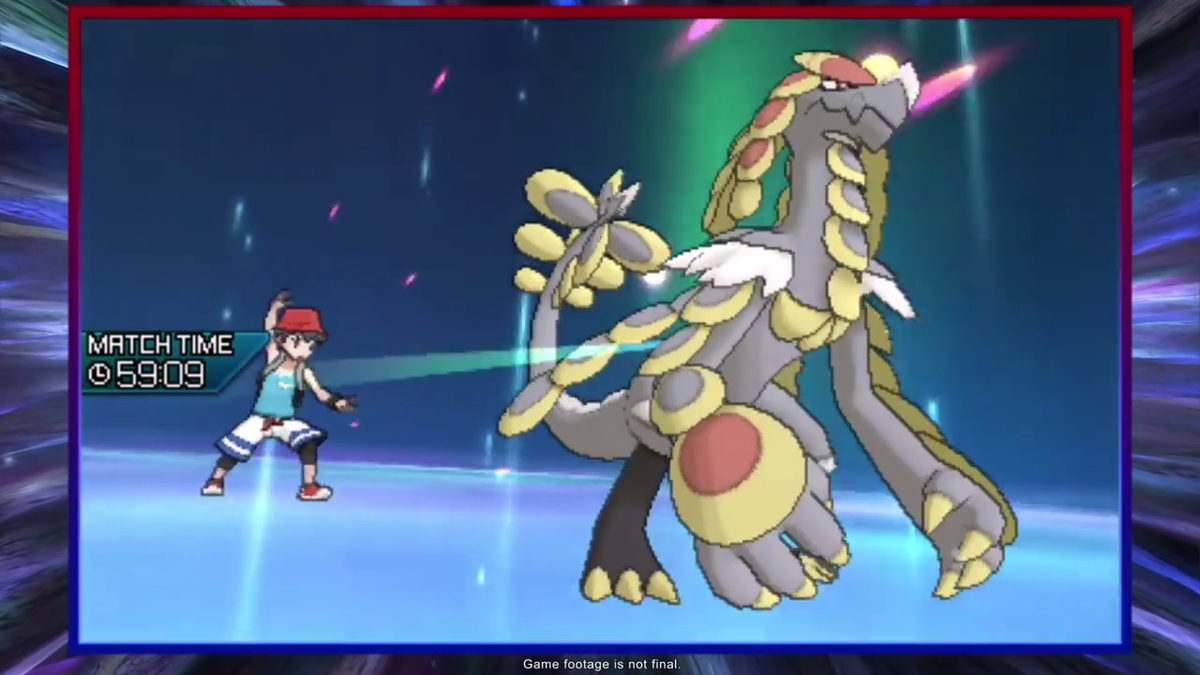Search
[{{{type}}}] {{{reason}}}
{{/data.error.root_cause}}{{{_source.title}}} {{#_source.showPrice}} {{{_source.displayPrice}}} {{/_source.showPrice}}
{{#_source.showLink}} {{/_source.showLink}} {{#_source.showDate}}{{{_source.displayDate}}}
{{/_source.showDate}}{{{_source.description}}}
{{#_source.additionalInfo}}{{#_source.additionalFields}} {{#title}} {{{label}}}: {{{title}}} {{/title}} {{/_source.additionalFields}}
{{/_source.additionalInfo}}- Details
- Category: 3DS
- By Cinque Pierre
- Hits: 6978
Pokemon Ultra Sun and Ultra Moon (3DS)

Pokemon Ultra Sun and Ultra Moon
Developed By: Game Freak
Published By: Nintendo/The Pokemon Company
Released: November 17, 2017
Available On: 3DS
Genre: RPG
ESRB Rating: E for Everyone: Mild Cartoon Violence
Number of Players: 1-4 players
Price: $39.99
Another year, another mainline Pokemon release. Going over 20 years and still strong, Pokemon Ultra Sun and Ultra Moon are the latest entries to the multi-billion dollar franchise coming out just one day shy of a year after Pokemon Sun and Moon. Ultra Sun and Ultra Moon (abbreviated USUM) are the last entries to the 3DS line and possibly the last handheld entries as well (though the latter statement can only be assumed). USUM are enhancements to Sun and Moon, the Generation 7 games that came out last year. USUM, like previous enhancement games such as Crystal, Emerald, and Platinum, add new game modes, tweak existing features, expand on the movepool of existing Pokemon and other various fixes to the games. As these are enhancement games, I will mostly talk about a few new features they added into the game.
The main plot of USUM revolves around Necrozma, a Pokemon related to Solgaleo and Lunala who has lost its light and seeks to find it, even if it means stealing the light from another world. Because of this, a group from the same world as Necrozma known as the Ultra Recon Squad travel to Alola to find a means of stopping Necrozma. Some of the things they do with Necrozma are pretty neat and interesting, though about 90% of the plot is the same as SM, with minor differences here and there and the URS meeting you at certain intervals. Without going into too many spoilers, at the climatic battle between you and Necrozma, Necrozma reveals a hidden surprise which for many players may culminate into one of the hardest battles the mainline series has ever seen. For casual players, this could be seen as a detriment to the enjoyment they might get from the game. Other players may welcome the extra challenge.
The first notable new feature of USUM is the Alola Photo Club. People who previously played SM noticed these empty lots all across the city of Alola. In USUM, most of these empty lots have now been replaced by the Alola Photo Club. These new buildings let you take pictures with your party Pokemon, allowing you to bond with the creatures that accompany you. At first, I dismissed this feature since I didn’t particularly care for taking photos, but when going into the mode and messing around with the various features, I found out the photo mode has a lot more depth than it shows on the surface. There are various backgrounds in which one can use as a backdrop, with more being unlocked as you progress through the story and some even being unlocked when you transfer Pokemon from the Pokebank that originated from previous generations. These pictures are saved to your SD card and can be shared online via the Festival Plaza. There are also special effects and angles you can use, which can lead to pretty humorous situations. It’s a nice feature that surprised me quite a bit for how much they put into it.

Strong Points: Adds new Pokemon both in the way of the regional dex and completely new Pokemon in general. Additional sidequests are added to expand on the lore of the Alola region.
Weak Points: The overall story is mostly the same. Didn’t do much to optimize the engine to stop moments of frame drops.
Moral Warnings: Some of the Pokedex entries tend to depict more “violent” aspects of the obtainable creatures. Same questionable aspects of fighting animals, evolution, and occult imagery.
One complaint that I’ve heard of was that in SM, people criticized the Rotom Dex for just being a glorified map. Now in USUM your Rotom companion does more things such as ask you questions. If you answer these questions, you’ll gain affinity, and if your affinity is high enough, Rotom will also give you special items called Roto-Powers. People familiar with generations 5 and 6 will know these items as Pass or O-Powers, as they work very similarly to them but have their share of differences too. The main differences between Roto-Powers and Pass/O-Powers is the fact that Roto-Powers are consumable items given to you randomly instead of menu items that you need to level up to get increasing features. The Roto-Powers give you temporary enhancements such as allowing you to receive more prize money, letting you encounter Pokemon at a higher rate, or decreasing the amount of steps needed to hatch eggs. You’ll know when you’re ready to obtain a Roto-Power when the Rotom on the bottom screen has a “bored” expression. Usually if you touch its eyes or his sides it’ll react and its eyes will glow. When you touch the glowing eyes, Rotom will then give you a random power, in increments of two. On average, once your affinity is high enough, this feature is triggered every 10 or so minutes. I do like the fact that the Rotom is more expressive and it gives off more of the feeling that you’re traveling with a sidekick but the bottom screen is still largely passive and that you do not have control over which Roto-Power you receive (without save scumming) can be pretty annoying at times.
The next big feature is the Battle Agency, which is unlocked about halfway through the story. It's accessible through the Festival Plaza. People familiar with either the Pokemon Stadium series or the Battle Factory from Emerald and Platinum versions will remember this feature. You have a selection of three Pokemon, and you have to choose one. As for the other two, you have to recruit two other trainers who have to battle with you. You can obtain two trainers from the usage of connecting online or streetpass. If you don’t have online access or are unable to streetpass, the game will give you two trainers, but you have no choice of the trainers and what Pokemon they use. After the selection, you do a state of three battles and if you complete and win those battles, you earn Festival Coins and rank up, which raises the Pokemon that you personally chose up by one level, up to a maximum of level 100 (or so I heard). After every 10 ranks, in the third battle, you face against a boss. After rank 10, the battlefield will start to have various effects such as weather or terrain effects so at times you’ll have to adjust your strategy accordingly. I always adored the aspect of rental Pokemon so I do enjoy the feature, but it's also heavily reliant on the people around you. As you go up the ranks, your opponents' Pokemon levels also get higher so if the people around you are still at rank 0, you’ll have to make due with level 50 Pokemon while your opponents' levels keep getting higher and higher.
As like with other enhancements there are various new forms for existing Pokemon, but for a first in the mainline games' history, USUM introduces completely new Pokemon that aren’t tied to a future game. USUM adds five new Pokemon never seen before, four of them being part of the Ultra Beasts, and one of them being a Mythical, which hasn’t officially been revealed yet. Usually, when a Pokemon game introduces a new Pokemon, it's typically an advertisement for the next generation of Pokemon games but these five new creatures are completely tied to the generation 7 games and have their own Pokedex entries. New Pokemon are always welcomed and in some instances, I hope that this becomes a trend for future Pokemon games. I am sad that these games did not feature new Alolan variants. I personally liked the alternate takes to older Pokemon and was expecting more variants such as an Alolan Ponyta/Rapidash or even an Alolan Vileplume or Bellossom.

Higher is better
(10/10 is perfect)
Game Score - 84%
Gameplay - 17/20
Graphics - 8/10
Sound - 10/10
Stability - 3/5
Controls - 4/5
Morality Score - 73%
Violence - 7.5/10
Language - 8/10
Sexual Content - 7/10
Occult/Supernatural - 7/10
Cultural/Moral/Ethical - 7/10
In terms of moral warnings, USUM would probably get a slightly higher scale on the morality chart than SM as it removed some suggestive scenes that were present in the previous games such as the Grass Island Trial cutscene. Said scene which could have some pretty inappropriate implications was exchanged for a radically different scene. Going into the Pokedex entries, Generation 7's Pokedex entries tend to be on the more violent side, as instead of talking about certain aspects of a Pokemon such as their body features, it talks more about the predator-prey aspects and states that a lot of Pokemon get eaten or even outright states the concept of death in some of its entries. Since these are enhancement games, it's still gonna share most of the warnings Sun and Moon (and Pokemon games in general) did such as the concept of animals/creatures fighting for sport, the concept of evolution, occult imagery, questionable dialogue from some NPCs and so on. Pokemon in general is a very kid friendly series as evident of the millions of children that play these games, and most of its questionable content only really get noticedby older players as they are old enough to understand certain aspects as these things will fly over most kids heads. For a more in depth detail into these warnings, one can see the morality section in our Pokemon Sun and Moon review.
Overall, Pokemon Ultra Sun and Ultra Moon is more of the same that you’d expect from Pokemon at this point. You grab your bags and go on an adventure with a customizable team of misfits to become champion. I’ve been saying a lot of positive aspects of the game, but I’m also a Pokemon enthusiast. I’ve been playing the games since the beginning, owning every mainline game in the series, as well as most of the series' spinoff games but when looking from it at a reviewer's point of view, it's hard to recommend these games to people who have previously played Sun and Moon. The new music and remixes of older pieces are solid and sound well. It shares many of the same issues that SM had such as the high amount of interrupting cutscenes that can break the flow of the game, the poor optimization due to the extremely high polygon count of the character models, the unbalanced encounter rates, and has its own set of issues such as features being brought back just to be worse than the predecessor, or being a full price enhancement for just some changes here and there.
For casual players, there isn’t a whole lot of features added for them to warrant taking another trip to Alola but for the more enthusiastic players or people who missed out on SM, I think there are enough additions to the battle system and additions to Pokemon to stay updated with online and local battling and put down money for these entries. In the case of the enthusiasts, if you really like the PvP aspect, you’re kinda more or less forced to “update” as SM misses out on a lot of compatibility with USUM. I believe USUM are solid sendoffs to the 3DS line and I await to see what they have in store when Pokemon comes to the Switch.
-Cinque Pierre






